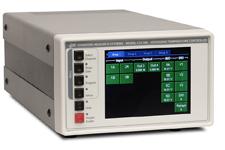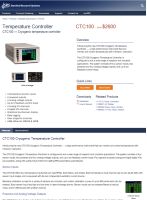Stanford CTC100 Programmable Cryogenic Temperature Controller

Stanford CTC100 Programmable Cryogenic Temperature Controller
Analog and digital I/O's, data logging, numeric and graphical display

Introducing the new CTC100 Cryogenic Temperature Controller - a high performance instrument that can monitor and control temperatures with millikelvin resolution.
The CTC100 Cryogenic Temperature Controller is configured to suit a wide range of research and industrial applications. The system consists of four sensor inputs, two powered and four analogue voltage outputs, and up to six feedback control loops. Four general purpose analogue and eight digital I/O's are available, along with autotuning functions for setting PID parameters automatically.
Sensor Inputs
The CTC100 offers four temperature inputs that can read RTD's, thermistors, and diodes. Each temperature input channel has its own 24-bit ADC with eleven input ranges, and is equipped with its own independent excitation current source.
Standard calibration curves for a variety of sensors are included, and custom calibration curves of up to 200 points each can be entered. Each sensor input has high and low level or rate-of-change alams. Sensor inputs can be lowpass-filtered to reduce noise, and/or differenced with another channel.
Powered and Analog Voltage Outputs
The CTC100 has two heater outputs. Either heater output alone can deliver up to 100W of power to a 25? heater. When operated simultaneously, the two outputs can deliver a total of up to 150W of power. In addition, four analog voltage I/O channels can be used to drive heaters with the help of an external amplifier.
For further information please contact us or download the datasheet.

